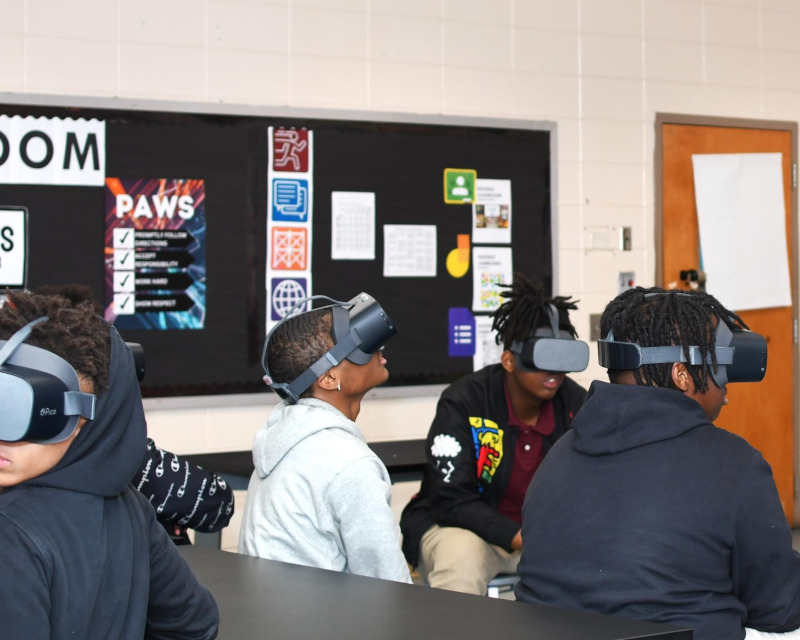Hancock County Schools
Doing what’s right for the student
A small rural school district primes its students for success
Hancock County, Georgia was founded in 1793 and named for John Hancock, a signer of the Declaration of Independence. Located some hundred miles southeast of Atlanta, today, this small rural enclave, approximately 70% Afro-American, has a population of about 8,500, a third of whom live below the poverty line.
The Hancock County School District knows that embracing challenges and providing opportunities is the key to educational success. This progressive and hard-working school district comprises 210 employees — teachers, custodial staff, food service workers, bus drivers, para-professionals, administrators, and office personnel and serves about 850 students from early Head Start through 12th grade in the Marvin E. Lewis Elementary School, Hancock Central Middle School, and Hancock Central High School.
The district is led by its Superintendent, Dr. Alma D. Harper, who began her teaching career in Hancock County in 1998, and two of her chief administrators: Dr. LaTrasha Palmer, Director of Curriculum and Instruction, and Dr. Mesha Mathis, Federal Programs and Special Education Director. Their mission is to make sure that each student in the district can read, write, and think – three basic educational necessities for successful learning and successful living in later life.
The school day
“We start our day at 7:15 or 7:30,” says Harper. “That’s when the first buses arrive. They have their breakfast, and around 8 o’clock (all Hancock County students are eligible for free breakfast and lunch) they’re heading to their classrooms. At the elementary school, everyone has their routine. Some teachers may start the day with a writing exercise, while others may focus on mathematics. The middle and high schools are different because the kids are older.”
“Each school has a different instructional framework, where we’re mandated to follow the curriculum of instruction that guides us from the State of Georgia,” explains Palmer. “And since we put a lot of attention on students being able to read, write, and think in all the curriculums, those principles are included in each of the areas – whether it’s social studies, science, or CTAE (Career Technical & Agricultural Education). For example, within that instructional framework, at the elementary level, we use the i-Ready curriculum in math and reading.” (i-Ready is an online program, created by Curriculum Associates, for reading and/or mathematics that helps teachers determine, diagnose, and assess their students’ needs, personalize their learning, and monitor their progress throughout the school year.)
“In all of our areas, we make sure the children are engaged and ready, that they are modeling, that they are collaborating, and that they’re going through interdisciplinary units with performance-based learning tests,” Palmer adds. “Finally, we’re making sure that they are flowing through our new STEM (science, technology, engineering, and math) labs, which show how math, science, and all those subject matters come together. This way, we educate the whole child.”
Special programs for special needs
Poverty attacks a child’s health – physical, mental, and emotional. In Hancock County, many students with various disabilities have special needs. Mathis says that the district’s special education teachers support and co-teach alongside its regular classroom teachers.
“They follow around a caseload of students with disabilities to provide those supports within the class,” she notes. “In addition to that, we also have some students that we service through small group settings. In those situations, the teachers pull those kids out of class to work on those foundational skills that will help them be successful in obtaining access to the general curriculum.
“We have also integrated what we call a ‘sensory classroom’ for our neural-sensitive students who have issues with their sensory processing. This classroom allows an opportunity for them to go in and cool down. It’s a calming place where they can de-stress themselves so they can be successful within the classroom.”

How education is changing
In Hancock County, as elsewhere in the country, public education has changed recently in two profound ways: there is a severe teacher shortage in the U.S., and every year, fewer and fewer college graduates are choosing to make teaching their career; and because of COVID, there has been a rapid acceleration in the use of virtual instruction technologies in the classroom. And while the first phenomenon cannot be ameliorated with tools of the second, virtual instruction does seem to have come along at an opportune time.
“During the ’20-’21 school year, we were virtual here in our district,” Harper recounts. “That allowed us to see how the kids would respond. It may not be the ideal way to provide education, but I’m thinking if we can’t do something to get more people involved in education, virtually it may be one of those options where public education will have to go.”
Mathis agrees. “I do think that we will see more hybrid education where there will be virtual instruction as well as the option for face-to-face,” she says.
“With the declining number of teachers and people who are interested in going into the field, I think that this method will be used to address some of those shortages. Knowing this, we must stay on top of technology. And some of the things that we’re currently doing already incorporate technology within our classrooms.”
“For example, our students use Google Classroom and other virtual options to access their curriculum.” (Google Classroom is a free, blended learning platform developed by Google for educational institutions that aims to simplify and streamline the process of sharing grades and assignments between teachers and students. It has approximately 150 million users.)
Palmer offers a caveat: “Even if we do the hybrid model, our district will still try to incorporate different social activities for our children with the hope that, if we do go to more virtual learning, our students will still receive the social aspect which will enable them to excel outside of the circumference of our educational system.”
Mathis likewise hopes for a “more holistic” approach to education. “I think that we will see more focus on the social/emotional part of education,” she proffers. “That’s a big push now with so many students experiencing mental health issues. You will see more of a focus on that while incorporating academics into it.”
Infrastructure needs
Meanwhile, Hancock County schools need to be maintained and, when necessary, upgraded, renovated, and/or replaced. Harper provides a list of projects: “We are repaving parking lots to make sure that kids who come by car are safe. The roof of the elementary school is being redone and we’re possibly going to work on the roof of the high school.”
“We’ve made improvements to our football stadium with funds that came from our local SPLOST. We have artificial turf now. We have rubberized our track, which is big for us because it will actually give us the chance to hold track tournaments here. Our kids always must go on the road to compete. We’re starting a project, next spring, to renovate our gymnasium at the middle/high school with ESSER (Elementary and Secondary School Emergency Relief) funds through the CARES (Coronavirus Aid, Relief, and Economic Security) Act.”
“We are in the very early stages of talking about rebuilding our elementary school so that our Early Head Start, Head Start, Pre-K, and elementary school students will all be in one building. Our buildings are old and in much need of repair. It will probably be easier to build a new building rather than try to continue to fix the old ones.”
Mathis details upgrades within the classrooms.
“Using the extra funds that we received after the COVID pandemic, we made changes in our students’ furniture; they all got new desks, tables, and chairs. We were also able to create our STEM labs and we used some of those funds to purchase new computers – 300 desktop computers and 400 laptops.”
“We were also able to update our wireless router system. We also have been using funds to create our sensory classrooms for our students and we bought sensory toolboxes for all our teachers for use in the classroom. So, we have a lot of projects going on right now to improve the infrastructure here.”

Local and regional partners
Just as it “takes a village” to raise its children, it takes strong partnerships to support a local school district. The school district works closely with its valued partners including, SRJ Architects for the gymnasium renovation, GN Excavation and Trucking, for preparing the field, and the MOTZ Group for laying the artificial turf; MEJA Construction for remodeling the Middle/High School gym; Presence Learning for providing the district with its OPTP (Orthopedic Physical Therapy Products) and its school psychologist; the Oconee RESA (Regional Education Service Agency), which helps local school systems meet their educational needs through sharing services across school systems lines; Accelerated Learning for providing STEMscopes, its comprehensive suite of STEM curriculum and professional development solutions; and, of course, the Georgia Department of Education.
“We can call them whenever we need them,” says Harper.
Other partnerships include those that assist students directly.
“The Morehouse School of Medicine helps our students who are studying biology,” Harper shares. “They can do labs provided by the Medical School. In a couple of weeks, we will be journeying to Georgia Tech for another possible partnership in computer science. And we have other partnerships coming up – one with Oconee Fall Line Technical College. I’ll be meeting with them to explore more expanded opportunities for our students.”
Small can be beautiful
While Harper and her allies are confronting the challenges of being a small and relatively poorer school district, they all agree that smallness does offer some advantages. “We don’t have all the resources, but an advantage is that we know our community; we’re products of this community and the school district,” she shares. “A lot of problems that larger districts may have by not knowing their students, or their parents, or many of the community members, we don’t have. So, that is an advantage for us.”
“We are a small rural community,” Mathis concedes. “But one of its benefits is its sense of family. Everybody here knows everybody. We know the students, we know the parents. And, because we’re small, we do a good job of working with students individually. We’re able to cater to their individualized needs, where some of the larger systems can’t do that because they’re managing so many students.”
Doing what’s right
“When Dr. Harper became Superintendent, one aspect that stood out with me and made me elated, was knowing that we’re on a journey to be better than we were,” says Palmer.
“She stated that the Hancock County School District will do what is right for our children. That is what sold me; to know that we had a leader who is for our children and our community. And that means she will also be for me.”
The Hancock County School District’s mascot is the bulldog, and in conclusion, Harper says that there are certain things that every “bulldog” in the district needs: “Every bulldog should be safe and every bulldog should be healthy,” she states. “And if every bulldog can read, write, and think, we know every bulldog will be successful.”
AT A GLANCE
Hancock County Schools
WHAT: A public school district with programs from Early Head Start through 12th grade
WHERE: Hancock County, Georgia
WEBSITE: www.hancock.k12.ga.us



